Created: 06/24/2008
Updated: 03/07/2023
Ebook Reading Devices: Sony Reader, Kindle, Nook, Que, iPad, iLiad, ...
Which Ebook Reader Should It Be?
- Sony Reader PRS-505
- Sony Reader PRS-300
- Sony Reader PRS-600
- Sony Reader PRS-700BC
- Amazon Kindle
- Amazon Kindle 2
- Amazon Kindle DX
- Nook
- Que
- Txtr Reader
- JetBook
- XO2
- iLiad
- iRex 1000
- Cybook
- Mentor
- Rocket-eBook, REB-1100, Ebookwise-1150
- Asus Eee PC
- Touch Book PC
- iPad
- iPhone/iPodTouch
Executive Summary
- Best Purchase: SonyReader PRS-600 If you can't wait any longer and want an ebook reader get the SonyReader PRS-600.
- Best Purchase for Academic Article Reading: Kindle DX Although I don't like the Kindle because it locks you into buying ebooks from Amazon, if you mainly buy it to read academic articles, then the Kindle DX is a fair choice. Academic articles typically come as unsecured PDFs and can be loaded onto most mobile reading devices. The Kindle DX has the advantage of a large screen which is beneficial for articles which are mostly formatted in letter size.
- Best Entry Model: SonyReader PRS-300 Nice size and the cheapest option among the e-ink readers.
- Best Concept: XO-2 If the OLPC team can come close to their $75 retail price target and release date in 2010, then I am quite sure that this will revolutionize the ebook reader market.
- Most Reasonable Recommendation Wait! Currently there is a lot going on with new models and entrants into the e-reader market almost on a monthly basis. There is a proliferation of ebook formats and the support of the most popular format PDF could be better. Most devices still have many problems which could be avoided with some care. Also wait for flexible screens to make their debute shortly. Use your desktop, laptop and netbook PCs to read your ebooks and wait for the next generation of e-readers.
Sony Reader PRS-505
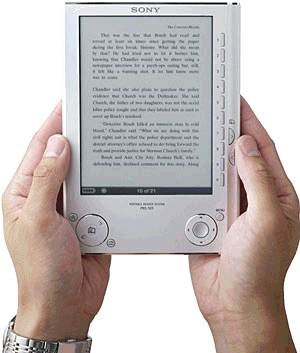 Sony has the distinct advantage of being the first to use the e-ink screen technology that has enabled a huge improvement in ebook readers. Sony's decade long experience with walkmans and other small mobile electronic devices also helps. Their first popular model the PRS 505 (seen on the right) is already the 3rd generation device. The first model was only available in Japan and was called the Librie. About a year later Sony introduced the PRS-500 in the USA. The model PRS-505 is a further improvement of that. This model was introduced in the UK September 3rd 2008. It is therefore also currently the only e-ink based ebook reading device that is available in the USA, Europe and Asia. The latest Sony model is the PRS-600 and PRS-300 discussed further down.
Sony has the distinct advantage of being the first to use the e-ink screen technology that has enabled a huge improvement in ebook readers. Sony's decade long experience with walkmans and other small mobile electronic devices also helps. Their first popular model the PRS 505 (seen on the right) is already the 3rd generation device. The first model was only available in Japan and was called the Librie. About a year later Sony introduced the PRS-500 in the USA. The model PRS-505 is a further improvement of that. This model was introduced in the UK September 3rd 2008. It is therefore also currently the only e-ink based ebook reading device that is available in the USA, Europe and Asia. The latest Sony model is the PRS-600 and PRS-300 discussed further down.
And most importantly the latest firmware of the PRS-505 adds support for DRM-PDFs (like the one you can read with Adobe Digital Editions) as well as the ePub format. It also supports PDF reflow making better use of the screen area.
This means that overall the PRS-505/300/600 is the best mobile ebook reading device available on the market today. It is sturdy, lightweight, appealing look and feel, good support of secure and unsecured formats, and strikes a good compromise between size and reading area. It is also one of the cheaper ones and can be had new for around $200 for the PRS-300 and around $300 for the PRS-600.
So what are the cons? We have to distinguish between generic problems stemming from the e-ink screen technology, which all other e-ink devices (Kindle, Iliad, Cybook, Mentor, etc.) suffer, too, and deficiencies coming from deliberate design choices by Sony.
Problems with the e-ink screen technology
Before I start criticizing this technology let me say that the e-ink screen is a huge improvement in screen technology when it comes to reading. It is truly electronic paper where white and black color pigments are moved to the screen surface producing an image that is unlike any other screen you are familiar with. Although not quite like paper it does come close to the experience reading from printed paper. One measurable advantage is the resolution which is about 170dpi. LCD screens have typically about 100dpi and a printed page 300dpi. However, 170dpi to the naked eye is close to perfect.The second fundamental advantage of an e-ink screen is its low power consumption. Once the ink particles have been moved in place the screen does not need any energy to keep its image. You can therefore read a page as long as you wish without draining the battery. Only a page turn will cost a short burst in energy and then it is back to standby mode without draining the battery. Current devices specify 5000 to 10000 page turns on one battery charge. You could be reading dozens of ebooks before you have to recharge.
One further advantage which is at the same time also a bit of a disadvantage is that an e-ink screen needs ambient light to be readable. This is great under strong light conditions because the screen remains readable under bright sun light. However at night in bed you will need a reading light. In those moments a back-lit LCD screen can be great. Unless you are a heavy night time reader I say it is more important to be readable in sunlight than when it is dark. I offer one suggestions to the device manufacturers: build into the device a little reading light. This could be easily achieved by including one or two white LEDs on a little boom that can be flipped or rotated out of the ebook reader to illuminate the screen. For me personally that would be much more desirable than the built in MP3 players.
However, so great the advance, there are still some real bummers with this technology. The biggest is the one second refresh time including a 'flash of black'. Whenever you turn a page it takes about one second for the screen to display the next page and you briefly see an inverted version of the page which is typically mostly black. The page turn delay itself is not that big of a problem, because turning a page in a real book also takes about a second, but for all the menu interactions from choosing an ebook, navigating to a specific page etc., this quickly becomes a real pain in the butt. At a recent industry convention I saw new e-ink screen models that could refresh in a shorter time and the engineers there told me that they can make it fast enough to show video, or about 60ms refresh time. Showing video would counter the low power consumption advantage and therefore I don't think the technology needs to be driven that far, but getting to about 200ms refresh for responsive interaction would be a huge plus. However, the 'flash of black' is quite annoying. I assume this has to be done to remove any ghost images and shadows, to reset the screen to a default state. But whatever the underlying reasons, this is something that needs to be fixed. Achieving a higher refresh rate would automatically take care of it as well. A black flash for 60ms would be hardly noticeable.
The contrast of the e-ink screen is more akin to newsprint. The white is not really white but light gray and the black is not really black but dark gray. For most reading it is not a big problem, but a higher contrast would allow the benefits of the high resolution to come through better.
The latest screen version has 8 gray levels (3 bit) whereas their earlier models only had 4 gray levels (2 bit). 8 levels of gray for a high resolution b/w screen is plenty in my opinion, particularly for text. Once we go into the reproduction of photos more levels would be advantageous but the low contrast is the bigger problem. And the high resolution allows one to use dithering to achieve enough shades of gray.
There are competing technologies to e-ink. Most notably Bistable Nematic screens manufactured by Nemoptic. Their advantage is faster, full color, retaining the advantages of extreme low power and paper like appearance.
For us consumers this is good news. Competing technologies mean strong downward price pressures and higher quality products. The primary reason why current ebook reading devices are so expensive is the price of the screen. Once the screen prices come down so will the end devices that use them.
PRS-505 homemade problems
The software controlling user interface and user interaction, what you see as menu, is a bit clunky and could be much more intuitive and powerful. Particularly ordering and sorting through a larger collection of ebooks is not very well supported. But this is only software and could quickly be fixed. If I would be Sony, I would open the software and let others do it for them. Their unit sales would shoot up immediately. There is so much more one could get out of this device. For example, why not turn it into a digital photo frame with a nifty slide show support. Or what about presenting your next PowerPoint to a colleague. And I am not even talking about games and other entertainment software that could run on these devices. For example, an adventure or brainteaser like game could work because it doesn't need high refresh rates.
With the release of the latest models, the PRS-300 and PRS-600, Sony has introduced improvements to the software. For example, support for Mac is now built in. Sony is on the right path and making progress.
Sony PRS-300
The differentiating feature of the PRS-300 is its smaller screen, only 5-inch diagonal. This is great if you want to tuck it into your jacket pocket or purse, but of course the screen area is smaller and will make reading less comfortable. However, the resolution is the same as the larger 6" screen, 800 x 600 pixels. This means that as long as your eyes are still good you will be able to see as much of a page as on the larger PRS-600 model. The price is just below $200 which makes the PRS-300 the ideal entry model for those who are not yet entirely sure about this 'ebook thing' and would like to give it a try. The biggest problem for me with this device is that it does not have a single memory expansion slot. There is also no built in MP3 player, but that shouldn't be a big problem for most.Sony PRS-600
This is the most recent top model of the line of SonyReaders. It includes a number of incremental improvements. Most notably notes can be taken by hand or with the built in virtual keyboard, and they can be exported to your computer and can then be printed out. This elevates note taking to a new level of convenience. The screen has been improved to reduce glare which apparently was a problem in older models. I never noticed it and never had a problem with it. But it is very encouraging to see that Sony is listening to its customers. The PRS-600 now has full support for Mac. Another big step in the right direction.The PRS-600 is the model I recommend to anyone who wants to buy an e-book reader and can't wait any longer.
Sony PRS-700BC
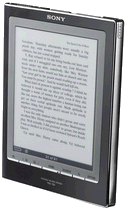 From what I can tell this model has been discontinued. This model improves on the PRS-505 in a number of ways. If it is worth the $100 more depends on your situation - list price is $399. Probably the most useful for many is the built in front light to allow reading during low or no light conditions. Sony offers a separate transparent cover for the PRS-505 (PRSA-CL1) which functions as a front light, but it costs $70. That is almost the price differential between these two models. So the built in front light of the PRS-700 is the much better alternative. The new reader also has a touch screen supporting page turns, highlighting, and a virtual onscreen keyboard for keyword searching and annotations.
From what I can tell this model has been discontinued. This model improves on the PRS-505 in a number of ways. If it is worth the $100 more depends on your situation - list price is $399. Probably the most useful for many is the built in front light to allow reading during low or no light conditions. Sony offers a separate transparent cover for the PRS-505 (PRSA-CL1) which functions as a front light, but it costs $70. That is almost the price differential between these two models. So the built in front light of the PRS-700 is the much better alternative. The new reader also has a touch screen supporting page turns, highlighting, and a virtual onscreen keyboard for keyword searching and annotations.
You also get five pre-set font sizes and zooming is as easy as tapping the screen. The internal memory is twice as large as the one of the PRS-505 holding on average 350 ebooks. And page turns are faster with a snappier refresh.
The main advantage as we see it is the touch screen which together with the faster screen refreshes results into a much more pleasant interaction. Switching from one ebook to another, adding bookmarks, checking the table of contents, accessing notes and searching, all of this needs user interaction which is on the model 700 much faster and more user friendly. You will be much happier using this model than any other.
For people who read mostly fiction, where one usually does not need to make annotations or search, and who don't need the front light the PRS-505 is the much more economical option than the PRS-700BC. However, if you need to search frequently, or if taking annotations is important, or if you like to read in your bed with the lights off, then the PRS-700BC is the better choice over the PRS-505.
Sony is working on a firmware update that will allow one to export ones annotations. And they are looking into wireless connectivity, although we do not believe that this is that important a feature, particularly if it comes with a hefty price increase.
Amazon Kindle
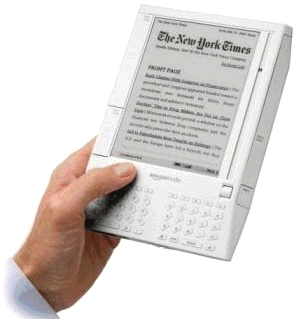 This is the device that received the most hype and attention so far, and although it features some improvements it is also in some ways a step back. For one, I can't help it, but it looks ugly. It has more the look of an early computer of the 1980s. I guess the main reason for this is the keyboard it sports. This should primarily be a reading device. So get rid of the keyboard or at the least hide it or make it an accessory. I do understand that for keyword searching a keyboard has its advantages, but it does not need to take that much visible space.
This is the device that received the most hype and attention so far, and although it features some improvements it is also in some ways a step back. For one, I can't help it, but it looks ugly. It has more the look of an early computer of the 1980s. I guess the main reason for this is the keyboard it sports. This should primarily be a reading device. So get rid of the keyboard or at the least hide it or make it an accessory. I do understand that for keyword searching a keyboard has its advantages, but it does not need to take that much visible space.
Besides all the pros and cons of the e-ink screen mentioned above under the Sony reader, the Kindle uses its own proprietary ebook format, the Mobipocket format (Amazon bought Mobipocket). And this is really a bad idea. It is extremely customer unfriendly, locking you into a proprietary format that might not be supported in the future, rendering all your ebooks useless. I hope Amazon does what Sony did and support DRM-PDF/ePub formats. If they don't I predict that the Kindle will soon be falling behind and quickly enter the museum as a failed idea.
One advantage the Kindle has is its free Whispernet EV-DO service that allows you to go online, check your email, and most importantly purchase and download ebooks wherever cellphones work. (This works only in the US. For example our Canadian friends are out of luck.) This eliminates the need to be at a wireless hotspot. This is certainly a nice feature but on the other hand I don't need to be able to purchase ebooks at any given moment. And this feature is currently limited to the Amazon ebook shop, which eliminates any price competition and is not conducive to lowering ebook prices for consumers. But one hopes that this monopoly will eventually be broken and consumers can choose where to buy their ebooks from.
At $359 the Kindle is one of the more expensive options. You can find a lightly used Sony Reader at half that price. The Kindle is therefore highly overpriced for what it offers.
Despite the fact that I think the Kindle is not a good purchase, Amazon has generated a lot of positive publicity for ebooks in general. Many more people are now aware of the existence of ebooks and what they are. And for that we have to thank Amazon.
Amazon Kindle2
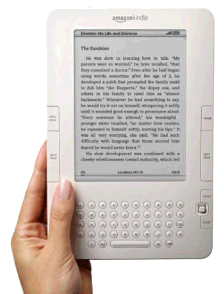 The Kindle 2 is an incremental improvement, but not a fundamental step forward. The visual design is better. However do we really need a keyboard on a reading device? The ratio of actual reading area to size of device is pretty miserable with the Kindle series of devices. The Sony PRS-700 uses the same screen module but comes in a much smaller form factor.
The Kindle 2 is an incremental improvement, but not a fundamental step forward. The visual design is better. However do we really need a keyboard on a reading device? The ratio of actual reading area to size of device is pretty miserable with the Kindle series of devices. The Sony PRS-700 uses the same screen module but comes in a much smaller form factor.
Where I have to applaud Amazon is with the text-to-speech functionality. I like that. Although I think actual use of this feature will be low, it is a great use of existing technology to enhance such a reading device. And visually impaired people will love it.
Increased storage space is not that important but a nice to have. Better e-ink screen brings the Kindle 2 on the same level as the Sony PRS-700 which uses the same model of E-ink screen.
The Kindle 2 is still a closed ebook reader where you can only buy ebooks from the Amazon shop. Shame on Amazon to try to monopolize ebooks. My recommendation remains. Stay away from the Kindle 2.
Amazon Kindle DX
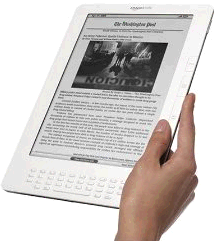 This is Amazon's attempt to monopolize the magazine, newspaper, academic journal and textbook market. There is little new here compared to the Kindle 2. One improvement in software is native support for PDF. You can, without conversion, read a PDF on the Kindle DX. However, you will not be able to change fontsize. The main difference is that Kindle DX is bigger (9.7" screen diagonal) and more expensive (~$500), and allows you to view larger sized documents better. However, bigger also means less mobile. To be frank, the Kindle DX is too large for me. A screen of this size needs to be flexible so that one can pack it away smaller and unfold it when reading. Flexible screens will come as early as 2009.
This is Amazon's attempt to monopolize the magazine, newspaper, academic journal and textbook market. There is little new here compared to the Kindle 2. One improvement in software is native support for PDF. You can, without conversion, read a PDF on the Kindle DX. However, you will not be able to change fontsize. The main difference is that Kindle DX is bigger (9.7" screen diagonal) and more expensive (~$500), and allows you to view larger sized documents better. However, bigger also means less mobile. To be frank, the Kindle DX is too large for me. A screen of this size needs to be flexible so that one can pack it away smaller and unfold it when reading. Flexible screens will come as early as 2009.
Before you order this jumbo sized Kindle compare in particular to Iliad and the one from Plastic Logic.
But let's not kid ourselves. $500 for an e-reader? I buy full featured computers for half that price. In my opinion netbooks will take most of the future e-reader market. Their battery lifetimes are getting in the 10 hour range which allows a full days of work and charging over night - enough for any workaholic or bookworm. Some come with detachable screens or eventually two screen models (see XO-2).
Nook
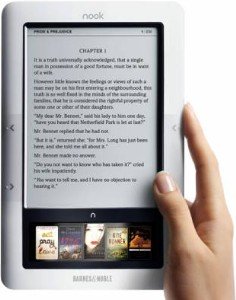 Barnes & Noble had to mount an answer to Amazon's Kindle or face loosing revenue in the transition from paper to digital. And of course Barnes & Noble had to say their Nook is better than what came before, but is it? At best it is a small incremental improvement to what Sony, Amazon, and other e-ink based readers have to offer. The two notable differences are the little color LCD screen and a lending-to-friends feature.
Barnes & Noble had to mount an answer to Amazon's Kindle or face loosing revenue in the transition from paper to digital. And of course Barnes & Noble had to say their Nook is better than what came before, but is it? At best it is a small incremental improvement to what Sony, Amazon, and other e-ink based readers have to offer. The two notable differences are the little color LCD screen and a lending-to-friends feature.
In my opinion the little color LCD screen is mainly there to confuse customers into believing this is a 'color reader', which it is not. The main reading area is greyscale as all the other e-ink based readers. The color screen at the bottom can show ebook covers in color and provide colorful menu navigation - but that is the least important use of color I can imagine. The little LCD screen does have one benefit though. It allows for a fast and responsive menu navigation. One of the problems of e-ink screens is that they need about a second to refresh. For navigating a menu this can become a real pain in the neck. The LCD screen which has no such response time issues provides for a fast and instantaneous interaction.
The lending feature is a more interesting new development. It allows you to lend some of your ebooks to a friend for up to 14 days. Not all ebooks enjoy this lending freedom. And you can lend each ebook only once. Meaning once you lent it out to a friend and the 14 days have passed you cannot lend it to somebody else ever. This is a very limited form of lending but it is at least a first tiny step in the right direction. My hope would be that the lending restrictions are less tight, perhaps allow more days to lend it out and allow more than one-per-lifetime lending of a particular ebook. A suggestion if anybody at Barnes & Noble reads this: Why not limit only the total lending days and not the number of people I can send this to? So if friend 1 returns it after 5 days one can send it to friend 2 and once he returns it one can send it to friend 3 a.s.o. until the total amount of lending days is consumed. I would think that something like 100 lending days would be a good start.
And of course, Barnes & Noble had to introduce yet another propriety and incompatible ebook format. I think many customers will be surprised once they find out that none of their ebooks (except unprotected PDF or EPUB ebooks) can be transfered from a Nook to a Kindle to a SonyReader and vice versa. This is one of the big challenges the publishing industry faces. My solution would be to drop DRM altogether or at least allow for some kind of federated DRM where a user can transfer an ebook to another reader platform.
Que
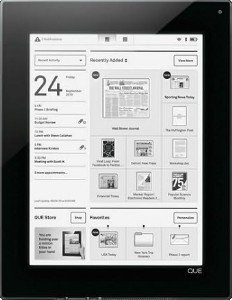 The Que from PlasticLogic is built on a highly interesting technology, but falls short in making use of it. The new technology is that the screen backplane is built from 'plastic transistors' rather than the silicon kind all other screens (e-ink or LCD) use. This would allow the Que to be a flexible screen, one that could be rolled up or folded to turn a large screen device into a small compact form for transportation. However, the Que is a rigid board. PlasticLogic has missed to capitalize on a huge opportunity.
The Que from PlasticLogic is built on a highly interesting technology, but falls short in making use of it. The new technology is that the screen backplane is built from 'plastic transistors' rather than the silicon kind all other screens (e-ink or LCD) use. This would allow the Que to be a flexible screen, one that could be rolled up or folded to turn a large screen device into a small compact form for transportation. However, the Que is a rigid board. PlasticLogic has missed to capitalize on a huge opportunity.
So you get a big board that you have to lug around - hardly a mobile device. That is one reason why the Que is targeted to buisness people who are supposedly carrying briefcases, but how many are these? The Que competes mostly with the Kindle DX. It has a large screen - close to letter size - which certainly provides for a nice reading experience. But there is nothing I can see that makes the Que better than any of the other devices already on the market. Once PlasticLogic turns this into a flexible device it would be able to leap ahead of the pack. Until then it is simply one of many possible choices.
Txtr Reader
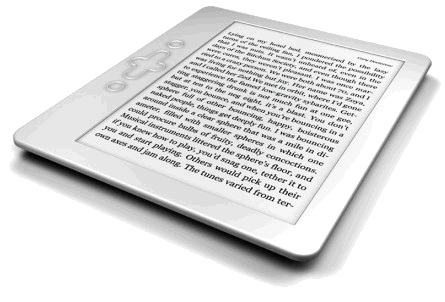 A very promising design concept is the Txtr reader from Germany. Visually it is wonderfully minimalistic, focusing on the important functionality of reading. It is an open architecture which is a very clever design choice. Hopefully some innovators will make good use of it. The price is EUR 299 which is a bit on the high side.
A very promising design concept is the Txtr reader from Germany. Visually it is wonderfully minimalistic, focusing on the important functionality of reading. It is an open architecture which is a very clever design choice. Hopefully some innovators will make good use of it. The price is EUR 299 which is a bit on the high side.
However, it appears that the annoying flicker during a page change is gone and the response to user interaction is much faster than other e-ink based devices. And it has an accelerometer like the iPhone to detect the orientation of the device and possibly to enable other cool applications. It uses the same DRM system that Sony uses. That means you can transfer your SonyReader ebooks to the Txtr. You can also move any ebooks you read with Adobe Digital Editions on your desktop or laptop to the Txtr. Kudos to the Txtr team for not creating yet another system but to build on what is already available and make it compatible. I very much hope that their open and compatible approach will be a success. It certainly is customer friendly.
JetBook
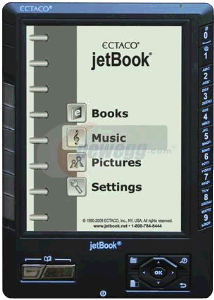 The JetBook offers a different alternative for an ebook reader. The primary difference is that it is not using an e-ink screen but an LCD screen that works with reflected light. That offers some advantages and some disadvantages. The biggest advantages are that page turns are much faster than with any of the e-ink based devices and contrast is better. The primary disadvantages are that it does not work with any of the DRM ebook formats and that the screen needs more power than the e-ink screen yielding only 20 hours of use before recharging whereas an e-ink based device typically runs for weeks if not months before recharging becomes necessary.
The JetBook offers a different alternative for an ebook reader. The primary difference is that it is not using an e-ink screen but an LCD screen that works with reflected light. That offers some advantages and some disadvantages. The biggest advantages are that page turns are much faster than with any of the e-ink based devices and contrast is better. The primary disadvantages are that it does not work with any of the DRM ebook formats and that the screen needs more power than the e-ink screen yielding only 20 hours of use before recharging whereas an e-ink based device typically runs for weeks if not months before recharging becomes necessary.
The form factor of the JetBook is similar to the SonyReader PRS-300 with a 5" screen diagonal. I like that the JetBook is even lighter than the SonyReader and that it supports a good range of formats. It also has a built in multilanguage dictionary. But I don't like the proliferation of buttons. The visual design could be better or cooler if you will. The price point, $200, is the same as for the SonyReader PRS-300. And some retailers for the JetBook such as Bed Bath & Beyond have their own store discounts pushing the price down to $160, making the JetBook the cheapest dedicated reading device at this form factor.
If you don't like the e-ink screen because contrast is too low or the time it takes to turn a page is too long then the JetBook offers a great alternative at an attractive price as long as you primarily want to read non-DRM ebooks.
XO2
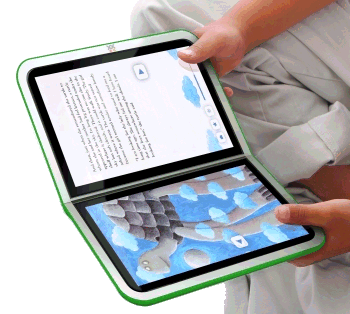 A fresh idea is the XO2, or version two of the $100 PC. It features two screens which can be used like a book, or a tablet, or like a laptop where one screen becomes a keyboard. Conceptually I like this design a lot. However, I doubt that this can retail for $75 as the One-Laptop-Per-Child (OLPC) organization claims. The screen is probably the most expensive component in a laptop. Having two screens makes this a very expensive proposition. Also typing on a touch screen is not that great. But it opens the possibility to have different language keyboards which is a plus in a global market.
A fresh idea is the XO2, or version two of the $100 PC. It features two screens which can be used like a book, or a tablet, or like a laptop where one screen becomes a keyboard. Conceptually I like this design a lot. However, I doubt that this can retail for $75 as the One-Laptop-Per-Child (OLPC) organization claims. The screen is probably the most expensive component in a laptop. Having two screens makes this a very expensive proposition. Also typing on a touch screen is not that great. But it opens the possibility to have different language keyboards which is a plus in a global market.
If OLPC can actually build this device with the battery lifetime and price they are targeting, then this would immediately become the best ebook reader known today. It would be a lot cheaper than your typical e-ink reader. It would have color screens, more reading area, fast response page-turning - and it would still be a regular computer with all kinds of free software available to view many file formats - an open hackable device. It would leave all other devices mentioned here in the dust.
iLiad
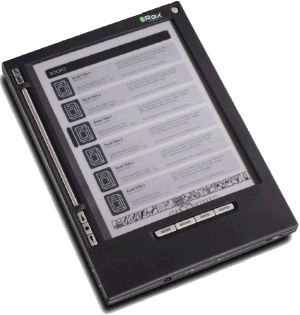 IRexTechnologies, the developer of the iLiad, is a spinoff from Philips. Philips was one of the early collaborators of E-ink corporation to bring a screen module on the market. The biggest differences of the iLiad to the Sony Reader and the Kindle is screen size and the touch screen. At 8.1 inch screen diagonal the iLiad is quite a bit larger than the 6 inch of Sony Reader and Kindle. This is particularly interesting for reading academic papers which are typically formatted to letter or A4 size. Although the screen of the iLiad is not A4 it is large enough that it is conceivable to read them. If the rendering software eliminates any white border and allows one to use the screen in landscape mode, then the screens width is pretty much the width of the text.
IRexTechnologies, the developer of the iLiad, is a spinoff from Philips. Philips was one of the early collaborators of E-ink corporation to bring a screen module on the market. The biggest differences of the iLiad to the Sony Reader and the Kindle is screen size and the touch screen. At 8.1 inch screen diagonal the iLiad is quite a bit larger than the 6 inch of Sony Reader and Kindle. This is particularly interesting for reading academic papers which are typically formatted to letter or A4 size. Although the screen of the iLiad is not A4 it is large enough that it is conceivable to read them. If the rendering software eliminates any white border and allows one to use the screen in landscape mode, then the screens width is pretty much the width of the text.
A nice to have feature is the touch screen. As I mentioned before during the Kindle description, I believe this should be mainly a reading device and should be optimized to reading rather than writing. However a touch screen expands the usage profile and is therefore an acceptable design choice. It also improves the user interaction which is already severely limited due to the one second refresh time of the screen. In the end it comes down to a cost trade off. At $699 the iLiad is already hopelessly overpriced. Nevertheless, the fact that one can take notes, underline, and capture sketches can be a useful and sometimes a necessary feature. In that sense the iLiad offers a very different device at a much higher price point. However, with the new Sony PRS-700BC, which also has a touch screen and allows highlighting and annotating, the iLiad has become an even less attractive option, unless you need the bigger screen. At that price my recommendation is to buy a subnotebook computer or a small laptop. Then you have a real computer at your disposal.
The iLiad sports a WiFi interface, not quite as useful as the Kindle EV-DO since you will need to be near a WiFi hotspot, but for the price almost a must have feature. However, I think that these interfaces are way overrated in terms of usefulness. As long as you can transfer ebooks to the reader via USB or a memory card, everything else is better removed to bring the price down as much as possible.
iRex 1000
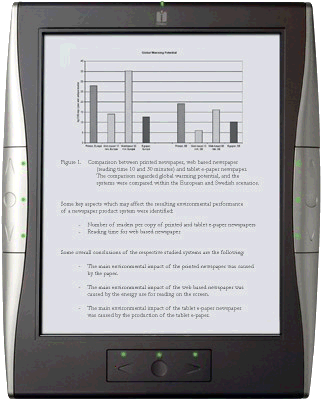 IRex decided to go for an even larger screen. Their latest model, the iRex 1000 has a 10.2 inch diagonal. That is very close to letter size or A4. For people who need to read documents formatted to such sizes (business documents, academic papers) this might be the ideal reading device. Other than the size it is pretty much the iLiad. However at $750 our recommendation remains - buy a real computer such as the Eee PC.
IRex decided to go for an even larger screen. Their latest model, the iRex 1000 has a 10.2 inch diagonal. That is very close to letter size or A4. For people who need to read documents formatted to such sizes (business documents, academic papers) this might be the ideal reading device. Other than the size it is pretty much the iLiad. However at $750 our recommendation remains - buy a real computer such as the Eee PC.
If you need a large screen also take a look at the reader from Plastic Logic, which was already demoed at a recent industry show, and should hit stores early 2009. It is a very thin letter sized device. Originally I thought this will be a flexible screen reader, however in the demo the reader looks rigid although very thin. The price is unknown but it will clearly compete with the iRex 1000 mainly for the business community.
Cybook
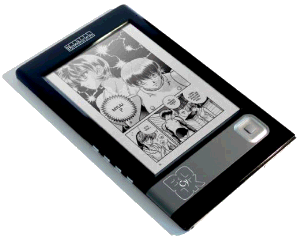 The Cybook by Bookeen is the French answer to Sony. It's list price is $350 placing it on par with the Amazon Kindle without the EV-DO wireless network. Biggest plus of the Cybook is its large internal storage of 512MB. (Sony Reader has 192MB, Kindle 180MB, iLiad 128MB.) But all devices support some kind of flash memory card allowing one to expand storage to the multiple GByte range. Internal storage therefore is hardly a real differentiation. I don't see anything particularly noteworthy here. Maybe the price is high due to the Euro/Dollar exchange rate. Since the Sony Reader is now also available in the UK and probably soon all over Europe I predict that the Cybook will quickly come down in price.
The Cybook by Bookeen is the French answer to Sony. It's list price is $350 placing it on par with the Amazon Kindle without the EV-DO wireless network. Biggest plus of the Cybook is its large internal storage of 512MB. (Sony Reader has 192MB, Kindle 180MB, iLiad 128MB.) But all devices support some kind of flash memory card allowing one to expand storage to the multiple GByte range. Internal storage therefore is hardly a real differentiation. I don't see anything particularly noteworthy here. Maybe the price is high due to the Euro/Dollar exchange rate. Since the Sony Reader is now also available in the UK and probably soon all over Europe I predict that the Cybook will quickly come down in price.
Mentor
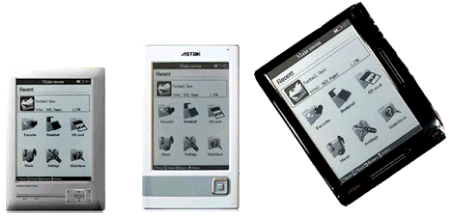 The Astak Mentor series of ebook readers offers three screen sizes, a 5" version a 6" version and a 9.7" version. These are not yet available but from what has been released allow me to make some guesses. The 5" diagonal version is too small for an ebook reading device. I could then stick with Palm, BlackBerry, or iPhone for reading digital documents. The 9.7" version was designed to read letter sized documents. For those applications this looks like a viable option if priced not too high, but the form factor is too large for a mobile device. Then a laptop would do, too. Once flexible screens are available screens of that size become very interesting. The 6" version is what Sony, Amazon, and Bookeen already offer - a good compromise. Hopefully these four devices will battle it out and prices will come down.
The Astak Mentor series of ebook readers offers three screen sizes, a 5" version a 6" version and a 9.7" version. These are not yet available but from what has been released allow me to make some guesses. The 5" diagonal version is too small for an ebook reading device. I could then stick with Palm, BlackBerry, or iPhone for reading digital documents. The 9.7" version was designed to read letter sized documents. For those applications this looks like a viable option if priced not too high, but the form factor is too large for a mobile device. Then a laptop would do, too. Once flexible screens are available screens of that size become very interesting. The 6" version is what Sony, Amazon, and Bookeen already offer - a good compromise. Hopefully these four devices will battle it out and prices will come down.
Summary of E-ink based devices
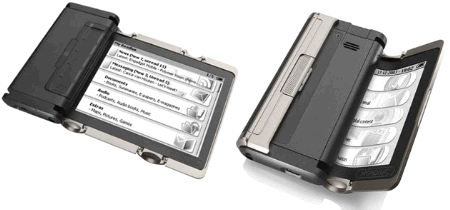 If we stay with the most popular screen diagonal of 6" you have several choices. All use the exact same E-ink screen module. The differences are in the user interface, support of ebook formats, and some nice to have features like wireless connectivity, touch screen, and storage size. At this point in time the Sony Readers are the only ones that I can recommend. The PRS-505 is the lowest price option and supports the largest set of formats including DRM-PDFs. This means that you can load and read all our PDF and DRM-PDF ebooks, and that means close to 100% of our catalog, on the Sony PRS-505. The same applies to the Sony PRS-700BC that comes with a built in front light and touch screen at about $100 more.
If we stay with the most popular screen diagonal of 6" you have several choices. All use the exact same E-ink screen module. The differences are in the user interface, support of ebook formats, and some nice to have features like wireless connectivity, touch screen, and storage size. At this point in time the Sony Readers are the only ones that I can recommend. The PRS-505 is the lowest price option and supports the largest set of formats including DRM-PDFs. This means that you can load and read all our PDF and DRM-PDF ebooks, and that means close to 100% of our catalog, on the Sony PRS-505. The same applies to the Sony PRS-700BC that comes with a built in front light and touch screen at about $100 more.
However, you might as well wait for flexible screens. As the concept device from Readius depicted on the right shows, flexible screens offer a completely new kind of mobile device. The combination of large screen with small enclosure to carry around in your pocket. Supposedly Readius will release their first flexible screen device 2009 in Europe.
Another company Plastic Logic has demoed in fall of 2008 their flexible screen device and will offer it early 2009. Plastic Logic's screen will be about twice the size of the Sony Reader. However, their demo did not show a flexible screen device. It is unclear to me if this was merely a limitation of the prototype or if the device will indeed be rigid.
Once flexible screen modules are available, it is likely that screen speed, contrast, and software have improved, too.
Rocket-eBook, REB-1100, Ebookwise-1150
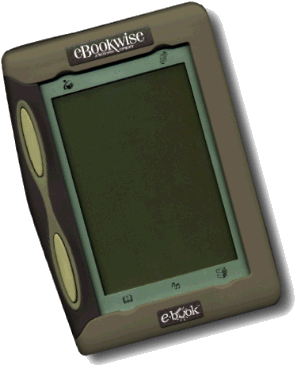 In 1998 an innovative startup, NuvoMedia, introduced the Rocket-eBook, the first successful true ebook reader. Before the Rocket-eBook the only option were PDAs such as the line of PalmPilots, Franklin's eBookMan (a somewhat more ebook friendly PDA), etc. The Rocket-eBook was overall a big success and largely responsible for the first wave of ebook enthusiasm riding along the Internet bubble. The screen was about the size of today's popular e-ink readers from Sony and Amazon. At that time E-ink was in its infancy and NuvoMedia had to resort to standard LCD screens. However, for 1998 the b/w screen was pretty nifty and very good for reading purposes. Remember the only other option were tiny PDA screens or heavy 'schlepptops'. They even had a touch screen and it worked for 10 to 20 hours on one charge.
In 1998 an innovative startup, NuvoMedia, introduced the Rocket-eBook, the first successful true ebook reader. Before the Rocket-eBook the only option were PDAs such as the line of PalmPilots, Franklin's eBookMan (a somewhat more ebook friendly PDA), etc. The Rocket-eBook was overall a big success and largely responsible for the first wave of ebook enthusiasm riding along the Internet bubble. The screen was about the size of today's popular e-ink readers from Sony and Amazon. At that time E-ink was in its infancy and NuvoMedia had to resort to standard LCD screens. However, for 1998 the b/w screen was pretty nifty and very good for reading purposes. Remember the only other option were tiny PDA screens or heavy 'schlepptops'. They even had a touch screen and it worked for 10 to 20 hours on one charge.
Unfortunately a big company, Gemstar eBook Group, acquired NuvoMedia in March of 2000, and that was pretty much the end of the success story. Once the Internet bubble burst there was no Rocket-eBook anymore. Gemstar through a licensing deal with RCA released a slightly modified version the REB-1100, but large companies are not innovative and nimble enough to care for a fragile baby like an ebook reading device through the storms of the Internet bubble burst.
It took another innovative startup, Fictionwise, owned by the Pendergrast brothers, to rescue the Rocket-eBook and continue to offer it as the Ebookwise-1150 for a bit more than $100. Since this is now essentially a decade old technology, I can't really recommend it anymore. But if you only want to spend a hundred bucks on a mobile reading device and you don't mind a bit heavier and thicker device, then this is a pretty good option.
Laptop, Desktop
I do a significant amount of reading on my various laptop and desktop computers. Having had a computer since my earliest teens, and even before that programing calculators and tinker toying with electronics, I am comfortable staring at a monitor for hours a day. I understand for many this is not convenient. But today's light weight laptops and sub-notebook computers are a good alternative as ebook reading device, if the latest e-ink reader is not yet it for you. The main advantage of a real computer is that you can do a lot more than reading ebooks.Asus Eee PC
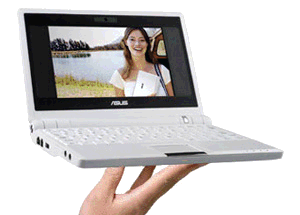 Particularly the line of tiny Eee PCs are very interesting. Considering that a new 2 GByte, 7 inch wide monitor ASUS Eee PC costs only $249, one has to consider this a real competitor to the various e-ink reading devices. Yes, it is heavier with 32 ounces (Sony PRS-505: 9 ounces, Ebookwise-1150: 18 ounces) and its battery life is only 3 hours, but it comes with all other standard features a computer has these days: color screen, USB, WiFi, ethernet connectivity, a keyboard, and an operating system with loads of software and applications to run on. And don't forget it is programmable! Additionally it boots up very quickly and can therefore be turned on and off frequently and rapidly. And its overall size is not larger than your standard 6 x 9 inch paper back.
Particularly the line of tiny Eee PCs are very interesting. Considering that a new 2 GByte, 7 inch wide monitor ASUS Eee PC costs only $249, one has to consider this a real competitor to the various e-ink reading devices. Yes, it is heavier with 32 ounces (Sony PRS-505: 9 ounces, Ebookwise-1150: 18 ounces) and its battery life is only 3 hours, but it comes with all other standard features a computer has these days: color screen, USB, WiFi, ethernet connectivity, a keyboard, and an operating system with loads of software and applications to run on. And don't forget it is programmable! Additionally it boots up very quickly and can therefore be turned on and off frequently and rapidly. And its overall size is not larger than your standard 6 x 9 inch paper back.
It is conceivable, with a bit of clever engineering, to turn such an Eee PC into a handy ebook reader. What if the screen could be folded all the way to the back to turn it into a tablet-type PC? What if the screen uses a bistable LCD technology like the earlier mentioned Bistable Nematic from Nemoptic? Then this Eee PC could be operated in reading mode where it needs very little power to run. And ultimately once an e-ink type screen becomes cheap why not add such a screen as secondary screen on the outside of the PC? Then one could use it as ebook reader in its closed state and once you need to type something or need the full power of a real computer you open it and are presented with a color screen and keyboard.
Touch Book PC
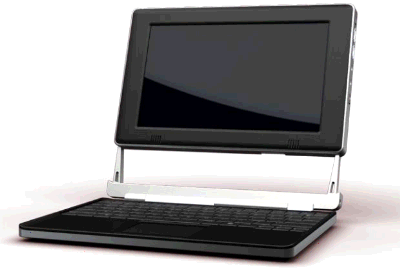 A few months after I wrote the paragraphs above a wonderful netbook computer was introduced: Touch Book - by a company called 'Always Innovating'. It pretty much is what I was envisioning and describing above. It can fold its screen back to become a tablet computer. Even better the screen can be detached and the screen works independently as tablet PC. Now that is a reading device that makes sense. One can either use the screen alone or attach it to the keyboard and now you have a full featured PC. This is the way to go. And the price is below that of the e-ink e-readers. And with the netbook market being a much larger market than the e-reader market prices of these puppies should come tumbling down fast. And we should see similar modular designs from other companies as well.
A few months after I wrote the paragraphs above a wonderful netbook computer was introduced: Touch Book - by a company called 'Always Innovating'. It pretty much is what I was envisioning and describing above. It can fold its screen back to become a tablet computer. Even better the screen can be detached and the screen works independently as tablet PC. Now that is a reading device that makes sense. One can either use the screen alone or attach it to the keyboard and now you have a full featured PC. This is the way to go. And the price is below that of the e-ink e-readers. And with the netbook market being a much larger market than the e-reader market prices of these puppies should come tumbling down fast. And we should see similar modular designs from other companies as well.
Such netbooks are likely to make e-readers entirely useless. Battery lifetime of the Touch Book is 10 hours. How much more do you want to work or read each day? Over night it charges up ready for another 10 hour off grid use.
iPad
 Initially when I saw the iPad I was a bit underwhelmed. However, once I actually used one I quickly learned to love it. Apple's magic draws you in. The large touch screen, the nice design, the wonderful visual appearance all of this makes it a unique mobile device opening up new ways to work with a computer. From that perspective I give it very high marks and can certainly recommend it. Of course, it is a pricey alternative if you only wanted to use it as ebook reader.
Initially when I saw the iPad I was a bit underwhelmed. However, once I actually used one I quickly learned to love it. Apple's magic draws you in. The large touch screen, the nice design, the wonderful visual appearance all of this makes it a unique mobile device opening up new ways to work with a computer. From that perspective I give it very high marks and can certainly recommend it. Of course, it is a pricey alternative if you only wanted to use it as ebook reader.
The iBooks app is great and the iPad can certainly be used as an ebook reader but it comes with a few caveats. The biggest is the glare of the screen. Depending on lighting conditions it is not as great a reading experience as an e-ink based reader. It is also heavier and does get noticeably warm after about an hour of use. Battery time is a lot shorter than your typical e-ink reader but with 5-7 hours of usage for the iPad you should be fine with nightly recharging. A big plus are the many apps you can get for the iPad. One app in particular is noteworthy for ebook readers: BlueFire Reader. This app allows you to read Adobe DRM protected ebooks as well as check out ebooks from libraries that offer ebooks. For more details see the article How to view DRM-PDF and DRM-EPUB ebooks on iPhone, iPad and Android.
If you can spend the money get an iPad for the sheer coolness and uniqueness. If you don't want to spend at least $500 it is best to wait for iPad 2.0 and see what improvements Apple has introduced.
iPhone/iPodTouch
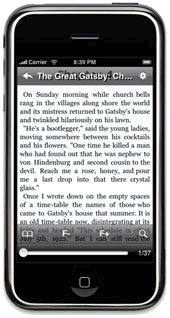 PDAs have largely been replaced with cell phones and the iPhone is the most coveted and successful cell phone to date. There is no reason why you couldn't read an ebook on an iPhone. There is even free nifty reading software available, such as Stanza from LexCycle. However, the limitation is the screen size. Just as with PDAs, the screen is too small for serious reading and on top of that you have a much shorter battery life that is measured in hours rather than days and weeks.
PDAs have largely been replaced with cell phones and the iPhone is the most coveted and successful cell phone to date. There is no reason why you couldn't read an ebook on an iPhone. There is even free nifty reading software available, such as Stanza from LexCycle. However, the limitation is the screen size. Just as with PDAs, the screen is too small for serious reading and on top of that you have a much shorter battery life that is measured in hours rather than days and weeks.
The iPhone is therefore not a replacement for the readers discussed above - it is not the Sony or Kindle killer as some pundits try to portrait it. And I don't think anybody would buy an iPhone or iPodTouch mainly to satisfy his urges to read. But if you already have such a gadget you can certainly fill a few idle minutes here and there with reading without having to carry around another device.
The only way the iPhone could seriously compete in the ebook reading space is when Apple figures out how to incorporate a flexible screen that opens up to 3- or 4- times the size of the current screen. Then my friends hold on, because that will be the day Sony and Amazon will not forget.
Replies
Salvador Calderon (04/05/2011)I just received yesterday my Sony PRS 700 and quickly uploaded all my lybrary.com books. I'm so grateful of all the insight I got here to pick a reader. Salvador Calderón magicshowbuilder.com
Christoph Wasshuber (02/14/2011)I have the Sony PRS-650 and I love it, too. It is a wonderful reading device. I use my iPad a lot, too, but not so much for reading. The SonyReader is ideal to always have a large selection of books ready to read at any given moment outside the home.
Simon Lea (02/14/2011)Just an update. I'm still using my Sony PRS-600 and I still love love it.
Simon Lea (06/21/2010)I went and bought the Sony PRS-600. Had it a week and I love it.
Scott Robinson (09/17/2009)This is a nice summary of Ebook readers. Although it is not possible to be complete, with a new one being announced just about every other week, I was surprised to see that you have missed an important one that has been out since the beginning of 2008. It is called the Jetbook and it has a specially developed non-lit (for clarity) LCD screen. Of the dedicated ebook reader screens mentioned above it is the best. Here's why.
Most of your listed readers are e-ink and are all pretty much the same and share the same problems. And although some of the weaknesses with this technology have been outlined above the major problem is the contrast. The typical contrast ratio is said to be a very poor 7:1 compared to newsprint which is 10:1. At 30% below the contrast of newsprint, e-ink is nowhere near it's quality (BTW computer screens are said to be about 1000:1). With such a low contrast I wonder if in fact it is appropriate for the visually impaired. Compare this to the Jetbook which is rated at a contrast ratio of 12:1, although still low it is 20% better than newsprint. In addition unlike the e-ink there is no flash of black to make the user queasy and the page refresh is almost instantaneous.
As people age the contrast ratio is the most important aspect to reading. Low contrast causes a much eyestrain. For this reason, in the current state of the technology, e-ink readers will not be the final answer for ebooks, whether it be in standard flat or flexible form.
Chris Ragaisis (01/22/2009)I've been an early adopter of eBook technology since the Rocket was first introduced. What an offering! The screen readability was superior to both the first and second generation eBookwise readers. I've gone through several of those units, Palms, PCs, and finally the Sony Reader. I'm grateful that anyone offers professionally formatted books for ANY of the devices. I've had to do most of that, myself. Now of only the folks at Sony would provide a Mac interface for the Reader I'd be a happy camper!
John Fells (10/15/2008)I was very grateful to Lybrary.com for bringing to my attention the Sony 505 PRS ebook reader. I had wanting to buy one for some time and the various reviews helped me to make up my mind and I now agree with Chris that the Sony PRS 505 is by far the best when price and features are considered. I can download ebooks from a variety of sources without restriction. I encountered a problem when attempting to read a password protected PDF. It could not be opened. However a friend directed me towards a password removal software for 10 dollars on the net, so no more PWD problems. Another disadvantage is not being able to search for a WORD or CHARACTER as one can do in a normal PDF, but it is after all a reader and as such it does a fantastic job. It has an SD Memory Card slot and a memory stick duo slot. A sync facility for ease of connection to a PC and file transfer. Ebooks can be grouped into collections so they can be easily organised in the ebook reader. And as a bonus an MP3 player and image player. The e-reader is really easy on the eye. Sharp black lettering on a grey screen and the font size can be adjusted by the simple push of a button which changes the size of the page to fit the screen. Really easy and makes for enjoyable trouble free reading. A back light would have been helpful for low light conditions but I suspect it would have effected battery life, which by the way seems more than satisfactory. I am still now about 5 days later running on full charge. The unit comes with around 30 books already installed but I couldn't wait to log on to Lybrary.com and download another Lewis Ganson PDF. On The Legacy PDF (Heirloom Effect by Jamie Badman - not a Lybrary.com ebook) the images didn't appear on the reader which I find strange because I had no trouble viewing images on Lybrary.com ebooks. On the whole you will gather that I am very pleased with my PRS 505. It also comes with a plastic cover, just like a book.
Simon Lea (09/09/2008)Thanks for this Chris. Borders are currently promoting the iLiad in their stores over here in the UK. As far as I'm aware they plan to sell them instore for £399. At that price, you are absolutely right, people are much better off buying a small laptop. I have an Eee PC, bought from Amazon for £200, and although it doesn't have the screen resolution of any of the eBook readers, its small size makes reading eBooks a lot more comfortable than a home PC or regular laptop. In addition, you can write documents, access the internet and play games.
I do a lot of writing and a lot of reading and so will at some point in the future own an eBook reader and a laptop. But at the current time the iLiad is too expensive to justify giving up using the Eee Pc for eBooks.